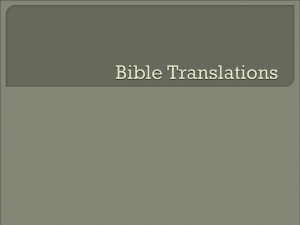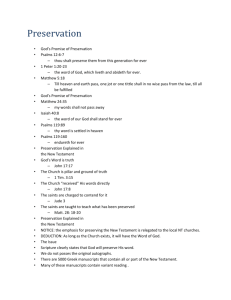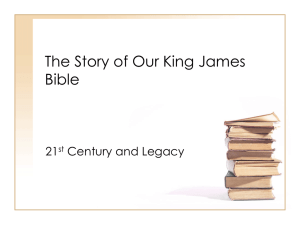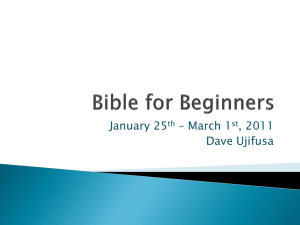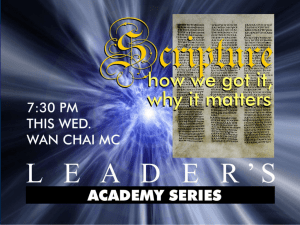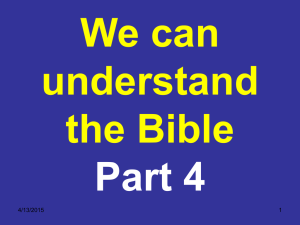Received Text Course..
advertisement
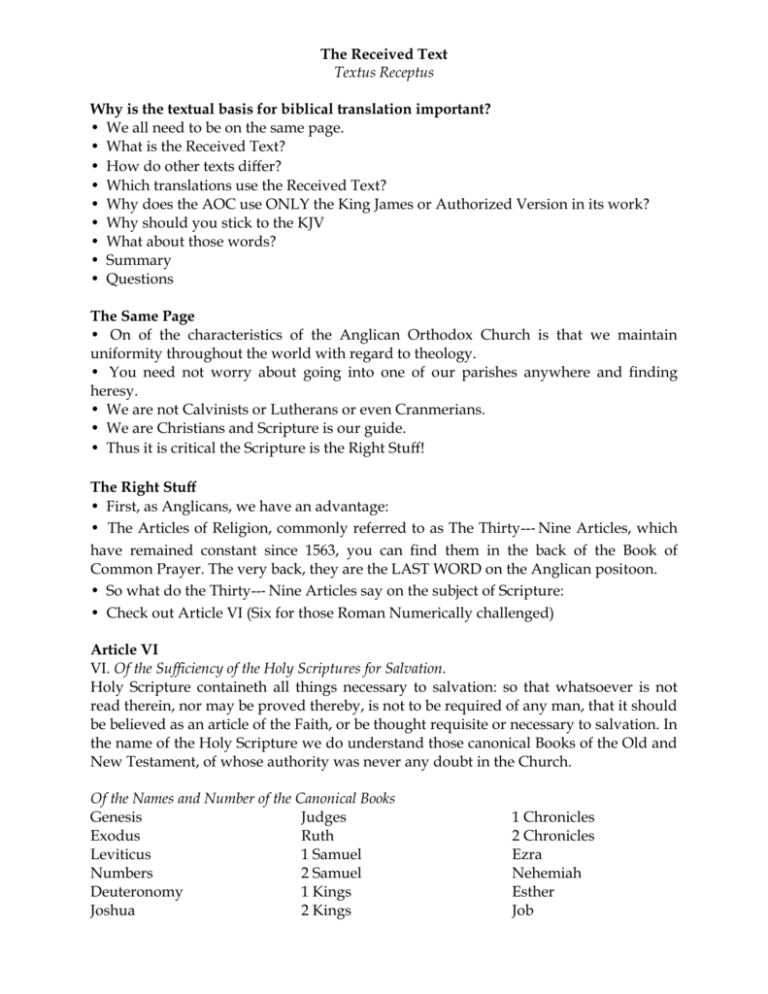
The Received Text Textus Receptus Why is the textual basis for biblical translation important? • We all need to be on the same page. • What is the Received Text? • How do other texts differ? • Which translations use the Received Text? • Why does the AOC use ONLY the King James or Authorized Version in its work? • Why should you stick to the KJV • What about those words? • Summary • Questions The Same Page • On of the characteristics of the Anglican Orthodox Church is that we maintain uniformity throughout the world with regard to theology. • You need not worry about going into one of our parishes anywhere and finding heresy. • We are not Calvinists or Lutherans or even Cranmerians. • We are Christians and Scripture is our guide. • Thus it is critical the Scripture is the Right Stuff! The Right Stuff • First, as Anglicans, we have an advantage: • The Articles of Religion, commonly referred to as The Thirty--‐ Nine Articles, which have remained constant since 1563, you can find them in the back of the Book of Common Prayer. The very back, they are the LAST WORD on the Anglican positoon. • So what do the Thirty--‐ Nine Articles say on the subject of Scripture: • Check out Article VI (Six for those Roman Numerically challenged) Article VI VI. Of the Sufficiency of the Holy Scriptures for Salvation. Holy Scripture containeth all things necessary to salvation: so that whatsoever is not read therein, nor may be proved thereby, is not to be required of any man, that it should be believed as an article of the Faith, or be thought requisite or necessary to salvation. In the name of the Holy Scripture we do understand those canonical Books of the Old and New Testament, of whose authority was never any doubt in the Church. Of the Names and Number of the Canonical Books Genesis Judges Exodus Ruth Leviticus 1 Samuel Numbers 2 Samuel Deuteronomy 1 Kings Joshua 2 Kings 1 Chronicles 2 Chronicles Ezra Nehemiah Esther Job Psalm Proverbs Ecclesiastes or Preacher Song of Solomon Isaiah Jeremiah Lamentations Ezekiel Daniel Hosea Joel Amos Obadiah Jonah Micah Nahum Habakkuk Zephaniah Haggai Zechariah Malachi And the other Books (as Hierome saith) the Church doth read for example of life and instruction of manners; but yet doth it not apply them to establish any doctrine; such are these following: The Third Book of Esdras, The Fourth Book of Esdras, The Book of Tobias, The Book of Judith, The rest of the Book of Esther, The Book of Wisdom, Jesus the Son of Sirach, Baruch the Prophet, The Song of the Three Children, The Story of Susanna, Of Bel and the Dragon, The Prayer of Manasses, The First Book of Maccabees, The Second Book of Maccabees. All the Books of the New Testament, as they are commonly received, we do receive, and account them Canonical. Only those things which can be clearly proved in Scripture must be believed to gain salvation. We accept the Old and New Testaments as listed above as Scripture. We think the Books of the Apocrypha have lessons in them, but do not believe they are of the same level as the two testaments and should not be used to establish doctrine. In other words, if it is not in the Bible, it need not be believed. We consider the King James Version, commonly called the Authorized Version to the standard for Scripture. We do not consider versions not derived from the Received Text to be valid, it should be noted that only the Received Text was referred to at the time of the adoption of the Articles. What is the Received Text? Textus Receptus (Latin: "received text") is the name given to the succession of printed Greek texts of the New Testament which constituted the translation base for the original German Luther Bible, the translation of the New Testament into English by William Tyndale, the King James Version, and most other Reformation--‐ era New Testament translations throughout Western and Central Europe. The series originated with the first printed Greek New Testament, published in 1516—a work undertaken in Basel by the Dutch scholar Desiderius Erasmus. It was based on six manuscripts, containing between them not quite the whole of the New Testament. The missing text was back-‐ translated from the Vulgate. Although based mainly on late manuscripts of the Byzantine text--‐ type, Erasmus' edition included some missing parts back translated from the Latin Vulgate. Frederick von Nolan, a 19th century historian and Greek and Latin scholar, spent 28 years tracing the Textus Receptus to apostolic origins. He was an ardent advocate of the supremacy of the Textus Receptus over all other editions of the Greek New Testament, and believed the first editors of the printed Greek New Testament intentionally selected the texts they did because of their superiority and disregarded other texts which represented other text--‐ types because of their inferiority. He felt it inconceivable the original editors of the [Greek] New Testament were wholly destitute of plan in selecting those manuscripts, out of which they were to form the text of their printed editions. In the sequel it will appear, that they were not altogether ignorant of two classes of manuscripts; one of which contains the text which we have adopted from them; and the other that text which has been adopted by those who would lead us astray. Edward F. Hills points out the principle that God provides truth through scriptural revelation, necessarily also implies that God must ensure a preserved transmission of the correct revealed text, continuing into the Reformation era of biblical translation and printing. The task of biblical scholarship is to identify the particular line of preserved transmission through which God is acting; a line which he sees in the specific succession of manuscript copying, textual correction and printing, which culminated in the Textus Receptus and the King James Bible. Hills argues that the principle of providentially preserved transmission guarantees the printed Textus Receptus must be the closest text to the Greek autographs; and consequently he rejects readings in the Byzantine Majority Text where these are not maintained in the Textus Receptus. He concludes Erasmus must have been providentially guided when he introduced Latin Vulgate readings into his Greek text; and argues for the authenticity of the Comma Johanneum. Hence the true text is found not only in the text of the majority of the New Testament manuscripts but more especially in the Textus Receptus and in faithful translations of the Textus Receptus, such as the King James Version. In short, the Textus Receptus represents the God--‐ guided revision of the majority text. How do other texts differ? • We are going to compare the King James Version (KJV) and the New King James Version (NKJV). • We picked the NKJV because the name sounds so similar that is must just be a modernized wording. • Right? • NOT! • Results would have been similar with all the “modern” translations: NIV, NASV, RSV, ASV, ESV and HSV Who says we don’t have a sense of humor? How do other texts differ? • Surely the King James and NOT New King James should be close enough --‐ (Acts 3:26) • KJV: 26 Unto you first God, having raised up his Son Jesus, sent him to bless you, in turning away every one of you from his iniquities. • NKJV: To you first, God, having raised up His Servant Jesus, sent Him to bless you, in turning away every one of you from your iniquities." (2 Corinthians 2:17) • KJV: 17 For we are not as many, which corrupt the word of God: but as of sincerity, but as of God, in the sight of God speak we in Christ. • NKJV: 17 For we are not, as so many, peddling the word of God; but as of sincerity, but as from God, we speak in the sight of God in Christ. (Titus 3:10) • KJV: 10 A man that is an heretick after the first and second admonition reject; • NKJV: 10 Reject a divisive man after the first and second admonition, Consider this: • Most of us who are faithful to Holy Scripture are considered "divisive" rather than inclusive. • But, what did Christ say on the subject of unity? Follow Me: For I am come to set a man at variance against his father, and the daughter against her mother, and the daughter in law against her mother in law. • Jesus does not seem that concerned about divisiveness, rather about unity around HIM. (Luke 17:19) • KJV: 19 And he said unto him, Arise, go thy way: thy faith hath made thee whole. • NKJV: 19 And He said to him, “Arise, go your way. Your faith has made you well.” Think about the Ten Lepers • Jesus healed all TEN. • Clearly the Samaritan’s faith did not make him well; • Clearly his faith made him whole, Jesus had already healed him. • Close enough? (1 Thessalonians 5:22) • KJV: 22 Abstain from all appearance of evil. • NKJV: 22 Abstain from every form of evil. (Isaiah 66:5) • KJV: Hear the word of the LORD, ye that tremble at his word; Your brethren that hated you, that cast you out for my name's sake, said, Let the LORD be glorified: but he shall appear to your joy, and they shall be ashamed." [This means that the LORD shall appear, which shall occur at the Second Coming of Christ.] • NKJV: Hear the word of the LORD, you who tremble at His word: "Your brethren who hated you, who cast you out for My name's sake, said, 'Let the LORD be glorified, that we may see your joy.' But they shall be ashamed." (Like the NIV, NASV, RSV and ASV, the Second Coming is wholly omired from this scripture.) Which translations use the Received Text? • German Luther Bible • Tyndale • King James Version Why does the AOC use ONLY the King James orAuthorized Version in its work? • ONLY ONE BIBLE CAN BE THE WORD OF GOD – There can be different wordings, but they must mean the same thing! • It has been estimated there are nearly one hundred versions of the Bible available in the English language today. • This multiplicity of Bibles does not alter the fact that God has inspired and safeguarded one Bible. • This one Bible is wriren in the Greek language in the New Testament and is called the Textus Receptus or Received Text. • The Old Testament has been preserved in the Masoretic Text and is wriren in Hebrew. • The Textus Receptus of the New Testament and the Masoretic Text of the Old Testament combine to give us the complete Word of God. • The King James Version of the Bible stands alone as the one Bible in use today which has been faithfully translated from these God--‐ given manuscripts. • All of the modern versions are based wholly or in part on corrupt texts. The chronology of the King James Version The New Testament was compiled by 400 AD. • By 170 AD --‐ --‐ 20 N.T. books had been accepted by the early Christians. • By 400 AD --‐ --‐ all 27 books of the N.T. had been accepted by the early Christians as they were guided by the Holy Spirit so that only the genuine books were included. • The Holy Spirit also guided in the selection of the pure manuscripts. • The Holy Spirit so guided that false gospels and manuscripts were set aside. • The original manuscripts were lost but the Received Text that was produced during this time was a faithful reproduction of the original autographs. • 452--‐ 1453 AD --‐ --‐ The Textus Receptus was used by the Greek Church during this time under the direction of the Holy Spirit. • 1516 AD --‐ --‐ Erasmus edited the first printing of the Greek N.T. This was in agreement with the Textus Receptus. • 1526 AD --‐ --‐ Tyndale's New Testament in English was printed. He was burned at the stake in 1536 because he had the Bible printed in English. • 1550 AD --‐ --‐ Stephens Greek N.T. (Textus Receptus). • 1611 AD --‐ --‐ The King James or Authorised Version of the Bible was translated from the Greek Textus Receptus in the N.T. and Hebrew Masoretic Text in the O.T. • 1611 AD --‐ --‐ To the present. Infidels and assorted enemies of the Bible have aracked our Bible in every way known to man, but God's Word shall abide forever. Why should you stick to the KJV? • Modern translations are not just simply different versions of the King James Bible written in contemporary language. These perversions are different Bibles entirely. Their foundation is not the God--‐ preserved Textus Receptus of the New Testament. Instead, they are based on contaminated, Christ--‐ denying manuscripts which had been rejected by the early church fathers. • This turning away from the true Bible to a wicked counterfeit is largely the work of humanistic scholarship. Men who call themselves textual critics have placed their thoughts and ideas above those of God and have presumed to improve upon that one Bible which has been given by God. One can only conclude that they have been so blinded by their compromise and delusions of self--‐ importance that they forget God has already given us His Word. The duty of every believer today is to take the one Bible which God has given and proclaim its glorious message of salvation to a sin--‐ sick world. • The fact is that as a general overview, the other translations are about 90 percent in agreement with the KJV. • Sounds good does it not? You can sound “modern” and be “almost right.” • Where do you think almost right fits in God’s Word? • Do you realize that the Jews agreed with 90 percent of what Hitler said? • The Devil is in the details. Ever heard that before? Close Enough? What about those words? • People don’t talk like that anymore. • People did not talk like that in 1611. The KJV was a conscious attempt to acknowledge and capture the majesty of God’s Word. The Bible IS the Word of God, after all. • There are about 200 words you may need to look up. This is nothing new – The Bible Word Book was first published in 1806 and is still in print. You can even get it free for you iPad or eBook reader. • Pull yourself up, reach down and give others a hand up. • Can’t means won’t. • God wants you to succeed, otherwise He would not have sent His Son to be our Savior! Summary • Most translations are pttery close(1) in the overall big picture; • However, “the devil is in the details,” literally. • There are so many places other translations twist the meaning. • Once you accept that twisted meaning, when you go to think of the details, you find yourself so far from course you many not be able to correct back. • Why get off course in the first place? Because you are too lazy to look up say 200 words? • Recall -- Close only counts in: Horseshoes, hand grenades and nuclear weapons. Questions
